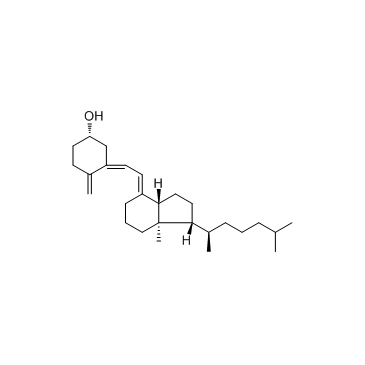67-97-0
| Name | calciol |
|---|---|
| Synonyms |
Oxarol
Vitamin D3 Ebivit Cholecalciferolum (3S,5Z,7E)-9,10-Secocholesta-5,7,10-trien-3-ol (1S,3Z)-3-[(2E)-2-{(1R,3aS,7aR)-1-[(1R)-1,5-Dimethylhexyl]-7a-methyloctahydro-4H-inden-4-yliden}ethyliden]-4-methylidencyclohexanol Cyclohexanol, 3-[(2E)-2-[(1R,3aS,7aR)-1-[(1R)-1,5-dimethylhexyl]octahydro-7a-methyl-4H-inden-4-ylidene]ethylidene]-4-methylene-, (1S,3Z)- Micro-Dee (5Z,7E)-(3S)-9,10-secocholesta-5,7,10(19)-trien-3-ol Deparal FeraCol MFCD00078131 9,10-secocholesta-5,7,10-trien-3-ol, (3S,5Z,7E)- Prezios cholecalciferol (1S,3Z)-3-[(2E)-2-[(1R,3aS,7aR)-1-[(1R)-1,5-dimethylhexyl]octahydro-7a-methyl-4H-inden-4-ylidene]ethylidene]-4-methylenecyclohexanol UNII-1C6V77QF41 Vi-De3 MC 1275 Granuvit D3 Devaron (3b,5Z,7E)-9,10-Secocholesta-5,7,10(19)-trien-3-ol cyclohexanol, 3-[(2E)-2-[(1R,3aS,7aR)-1-(1,5-dimethylhexyl)octahydro-7a-methyl-4H-inden-4-ylidene]ethylidene]-4-methylene-, (1S,3Z)- rampage vitamin D3 powder D3-Vicotrat NEO Dohyfral D3 (1S,3Z)-3-[(2E)-2-{(1R,3aS,7aR)-1-[(1R)-1,5-dimethylhexyl]-7a-methyloctahydro-4H-inden-4-ylidene}ethylidene]-4-methylidenecyclohexanol Vigantol EINECS 200-673-2 9,10-Secocholesta-5,7,10(19)-trien-3-ol, (3β,5Z,7E)- (1S,3Z)-4-Methylene-3-[(2E)-2-{(1R,3aS,7aR)-7a-methyl-1-[(2R)-6-methyl-2-heptanyl]octahydro-4H-inden-4-ylidene}ethylidene]cyclohexanol colecalciferol Videkhol (3β,Z,7E)-9,10-Secocholesta-5,7,10(19)-trien-3-ol [3H]-Vitamin D3 9,10-Secocholesta-5,7,10(19)-trien-3b-ol calciol Provitina VITAMIN D |
| Density | 1.0±0.1 g/cm3 |
|---|---|
| Boiling Point | 496.4±24.0 °C at 760 mmHg |
| Melting Point | 83-86 °C(lit.) |
| Molecular Formula | C27H44O |
| Molecular Weight | 384.638 |
| Flash Point | 214.2±15.1 °C |
| Exact Mass | 384.339203 |
| PSA | 20.23000 |
| LogP | 9.72 |
| Vapour Pressure | 0.0±2.9 mmHg at 25°C |
| Index of Refraction | 1.523 |
| Storage condition | 2~8°C |
| Hazard Codes | T+:Verytoxic; |
|---|---|
| Risk Phrases | R24/25;R26;R48/25 |
| Safety Phrases | S28-S36/37-S45-S28A |
| RIDADR | UN 2811 6.1/PG 2 |
| WGK Germany | 2 |
| RTECS | VS2900000 |
| Packaging Group | II |
| Hazard Class | 6.1 |
| HS Code | 2936240000 |


